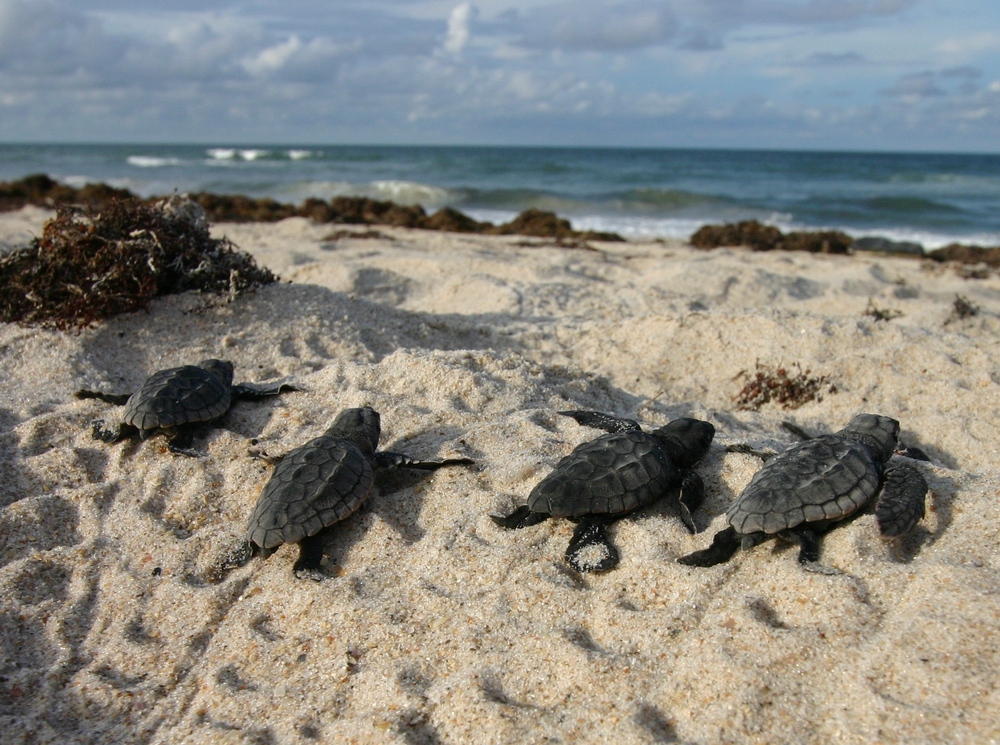
Fill in those holes in the beach and turn out beachfront lights — another sea turtle nesting season is upon us. On Amelia Island, volunteers work with state officials to handle nesting season work between the state parks on either end of the island.
“We are a group of volunteers who collect data. That’s our job, we’re data collectors,” said Mary Duffy of Amelia Island Sea Turtle Watch (AISTW) to a crowded Peck Center auditorium Monday night in Fernandina Beach. “We just have a lot of fun doing it. We do a lot of teaching along the way as well. We’re data collectors for the U.S. Fish and Wildlife Service and the Florida Fish and Wildlife Conservation Commission. Our training comes directly from them.”
The old high school’s auditorium was mostly filled by people new to walking the beach in the early morning hours to spot new nests. Sea Turtle Watch’s walking begins May 1 and runs through August 31, though actual nesting can go beyond that time, and hatchlings will emerge from nests as late as November.
The Florida Fish and Wildlife Conservation Commission is trying to get the word to people to be responsible and considerate of other living things that use the beach.
“Beachgoers can help native wildlife by properly disposing of all trash, filling in human-made holes in the sand and removing boats, beach toys and furniture from the beach before sunset,” according to a recent FWC statement. “Fishing line can be deadly to sea turtles, water birds and other wildlife, so be sure to dispose of it properly.”
Resorts also have to do their part.
“I talked to the Omni today about them moving their chairs, because they’ve got so much beach down there now, they’re pulling those chairs right down close to the water,” Duffy said. “They’ve got to pull them all the way back up and make sure they’re off the beach (by night).”
One of the few true conservation success stories in the Southeast in recent years involves sea turtles — in large part due to work completed in Georgia to preserve its unique coast. Amelia and the Talbot islands in Northeast Florida benefit from this legacy, and nest counts continue to climb. For instance, 2016-2018 had loggerhead nest counts in the AISTW area of 204, 175 and 143. Then 2019-2021, nest counts were 295, 166 and 179.
“Last year, we had a bunch of turtles, loggerheads, going up to the dunes and nesting on top of the dunes,” Duffy said.
The warmer a nest, the more likely the turtles will develop into females. Typically, that’s dictated by where the nest is laid — one on top of a dune is likely to be warmer. The issue is complicated by climate change, and there’s ongoing talk among sea turtle conservationists about whether such climate-driven issues will require wildlife managers to take action to ensure the birth of enough males.
This could be the seventh year the AISTW assists with gathering genetics data on the turtles. When they excavate nests, volunteers will take an egg from that nest, empty it and put the shell in a container with a preservative solution. It’s then sent off to a University of Georgia lab for mitochondrial DNA testing.
“We haven’t heard yet whether that project’s been funded for another three years or not,” Duffy said. “We’re still holding our fingers crossed that it is, because we get a lot of significant data from that, our genetic research.”
The Turtle Watch responds to dead and injured sea turtles as well. With regular dredging activity around Amelia Island, a wrong move can prove fatal for wildlife. One sea turtle managed to get through it, however.
“We got word this weekend, or yesterday, that one of the juvenile green turtles that we took up to Jekyll Island to the Georgia Sea Turtle Center died,” Duffy said. “We took it up a couple months ago, and they made a valiant effort to try to save that turtle, but they didn’t.
“At the same time, they also got a juvenile Kemp’s ridley that was caught in the dredge up on the north end (of Amelia Island). Now, that turtle is doing well. It’s got a long way to heal, but it’s showing some improvement.”



